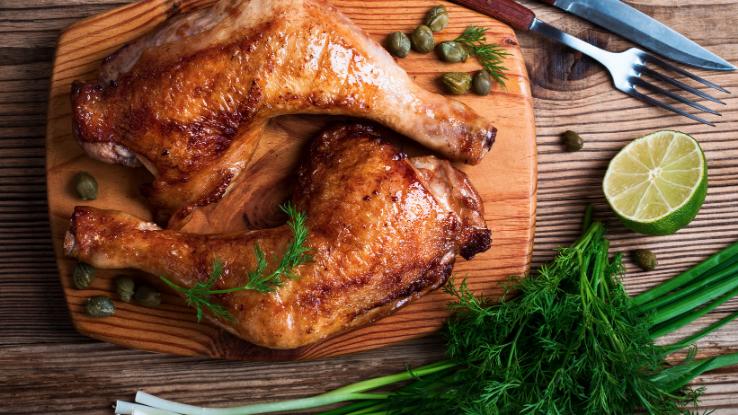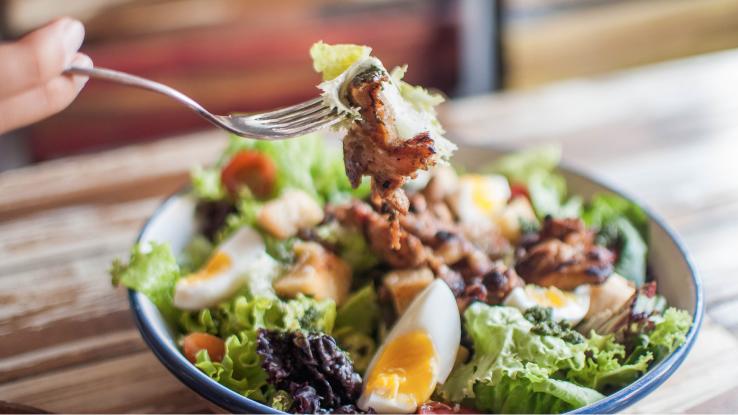How Much to Eat on Beef and Butter Fast

One of the most popular and versatile proteins worldwide is chicken. In fact, it's the most commonly eaten type of poultry in the world. Due to a shortage of beef and pork during World War II, chicken became a staple in the United States. Ever versatile, chicken can be cooked in a variety of delicious ways — and it's the star of many tasty recipes. An added bonus? Chicken contains many nutrients that are good for your health: Not only is it a great source of lean protein, but it contains several essential vitamins and minerals too. Want to know more? We've rounded up the top health benefits associated with eating chicken.
1. A Great Source of Protein
Protein-rich chicken is often considered to be one of the safest meat options since there are so few side effects or allergic reactions associated with it. Additionally, chicken meat also tends to be much leaner than red meat, so it is a healthier source of protein — and protein is pretty essential to any diet.

Protein is very important for building and repairing muscle, as well as strengthening hair and skin, and preventing bone loss in older people. Protein helps preserve your lean body mass (muscle) when you are on a diet. It also keeps your stomach feeling full for longer, so it can be an effective weight loss tool. Chicken is an important component of the heart-healthy, low-fat DASH diet (Dietary Approaches to Stop Hypertension), which advocates a lifelong approach to healthy living.
2. Plenty of Vitamins and Minerals
In addition to being a protein powerhouse, chicken contains numerous vitamins and minerals:

Tryptophan: This essential amino acid is important because it increases serotonin levels in the brain and helps us sleep better. It also has antidepressant properties and can make us feel happier.
Vitamin B3 (niacin): This vitamin is vital to the skin, digestive tract and nervous system; research has shown that it may help prevent Alzheimer's disease, helps convert food to energy, and promotes skin repair.
Vitamin B6: This vitamin helps with the metabolism of protein and red blood cells, and it may prevent heart diseases.
Vitamin B12 and choline: Together, vitamin B12 and choline help brain development in childhood, help the nervous system function properly, and improve cognitive performance as we age.
Selenium: An effective antioxidant, selenium can help in the prevention of cancer by repairing damage caused by free radicals in the body. It also helps maintain the immune system and normal thyroid function.
Phosphorus: Phosphorus helps us synthesize protein for the maintenance of cells and tissues and plays a role in the formation of strong bones and teeth.
3. Supports Cognitive Function
Vitamin B3, or niacin, is found in high levels in chicken meat and has been shown to be an effective preventative measure against age-related cognitive decline. According to nutritionists, regular intake of foods high in niacin, such as chicken, can protect the brain against Alzheimer's disease.

4. Helps Prevent Cancer
Along with niacin, chicken is rich in selenium, another antioxidant-rich nutrient. Selenium in chicken has been shown to induce DNA repair in damaged cells and eliminate abnormal or damaged cells. Selenium also activates an important antioxidant vital in cancer prevention, known as glutathione peroxidase, from proteins. All of this to say, consuming chicken may help in the prevention of cancers.

5. A Great, Versatile Staple for Any Healthy Diet
Here are some tips to make the most of this healthy food:

- The leanest chicken is white breast meat with the skin removed. However, you might prefer the flavor of dark meat from the leg or thigh.
- Keep the skin on when roasting a whole chicken or chicken breasts or thighs. The skin keeps the meat moist and adds lots of flavor. If you are counting calories, remove the skin before eating.
- Ground chicken can contain fat and skin, so for the leanest meat, reach for the pack labeled "90% lean" (or higher).
- Fresh or frozen chicken is a healthier choice than processed, deli-type chicken, which often has a lot of salt and other preservatives added.
- Grilling, roasting, and baking are healthier cooking methods than shallow- or deep-fat frying.
- Chicken is versatile because it is well-suited to many cuisines — try adding Mexican, Chinese, Italian, French, Moroccan or Indian flavors to your next chicken dinner!
- Chicken innards such as liver, heart and gizzards are also nutritious and often consumed around the world.
- Chicken meat has two to three times as much polyunsaturated fat, the "good" type of fat, than most types of red meat.
- A healthy serving size is 3 ounces (85 grams) per meal, about half of a chicken breast or a leg with thigh.
Tips for Preparing Chicken Safely

- Raw chicken can be frozen for up to two years.
- Always marinate or thaw chicken in the refrigerator rather than at room temperature.
- Be sure to wash all surfaces (countertops, sinks, cutting boards, utensils) and hands that come in contact with raw chicken meat with soap and hot water.
- Chicken meat should always be cooked thoroughly before eating, because raw chicken meat can carry the bacteria Salmonella that can make you very sick if ingested.
- Always cook chicken to an internal temperature of 165°F (~75°C).
Resource Links:
- Health Benefits: What are the health benefits of eating chicken? via Chicken Check In.
- "DASH diet: Healthy eating to lower your blood pressure" via Mayo Clinic.
- "How meat and poultry fit in your healthy diet" via Mayo Clinic.
- "Dietary protein and bone health" via National Library of Medicine.
- "Intake of niacin, folate, vitamin B-6, and vitamin B-12 through young adulthood and cognitive function in midlife: the Coronary Artery Risk Development in Young Adults (CARDIA) study" via National Library of Medicine.
- "Protein and Weight Loss: How Much Protein Should You Eat to Lose Weight?" via NASM.
- "Safe Minimum Cooking Temperatures Charts" via FoodSafety.gov.
Source: https://www.symptomfind.com/nutrition-supplements/health-benefits-of-chicken?utm_content=params%3Ao%3D740013%26ad%3DdirN%26qo%3DserpIndex

0 Response to "How Much to Eat on Beef and Butter Fast"
Post a Comment